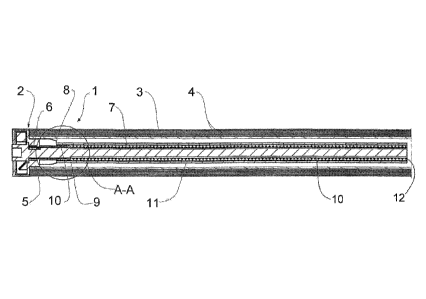Some of the information on this Web page has been provided by external sources. The Government of Canada is not responsible for the accuracy, reliability or currency of the information supplied by external sources. Users wishing to rely upon this information should consult directly with the source of the information. Content provided by external sources is not subject to official languages, privacy and accessibility requirements.
Any discrepancies in the text and image of the Claims and Abstract are due to differing posting times. Text of the Claims and Abstract are posted:
| (12) Patent: | (11) CA 2812749 |
|---|---|
| (54) English Title: | DEVICE FOR PRELOADING A REWIND MECHANISM |
| (54) French Title: | DISPOSITIF DE PRECONTRAINTE D'UN MECANISME ENROULEUR |
| Status: | Deemed expired |
| (51) International Patent Classification (IPC): |
|
|---|---|
| (72) Inventors : |
|
| (73) Owners : |
|
| (71) Applicants : |
|
| (74) Agent: | BERESKIN & PARR LLP/S.E.N.C.R.L.,S.R.L. |
| (74) Associate agent: | |
| (45) Issued: | 2018-11-20 |
| (86) PCT Filing Date: | 2011-11-10 |
| (87) Open to Public Inspection: | 2012-05-18 |
| Examination requested: | 2016-09-06 |
| Availability of licence: | N/A |
| (25) Language of filing: | English |
| Patent Cooperation Treaty (PCT): | Yes |
|---|---|
| (86) PCT Filing Number: | PCT/SE2011/051342 |
| (87) International Publication Number: | WO2012/064270 |
| (85) National Entry: | 2013-03-26 |
| (30) Application Priority Data: | ||||||
|---|---|---|---|---|---|---|
|
The present invention concerns a device (1) for preloading of a rewind mechanism (2) for a fabric (4) arranged on an elongated tube (3) or the like of a roller blind, a projector screen or the like. The rewind mechanism (2) is arranged to be essentially inserted into said tube (3) and includes a spring (10), that is tensioned when the fabric (4) is rolled out and relieved when the fabric (4) is rolled up onto the tube (3). The device (1) includes an outer mounting element (5), that is arranged to be attached to the tube (3), and an inner mounting element (6), that is arranged to be attached to an outer bracket (not shown), said mounting elements (5, 6) being rotatingly arranged in relation to each other about a longitudinal axis of said tube (3). A spring element (7) is arranged between said mounting elements (5, 6) and includes a sleeve (11), in which said spring (10) is arranged. The sleeve (11) has an inner diameter that is smaller than the outer diameter of the spring (10) in an untensioned condition, wherein said spring (10) is arranged inside the sleeve (11) by being inserted therein in a pretensioned condition.
La présente invention concerne un dispositif (1) de précontrainte d'un mécanisme enrouleur (2) pour une toile (4) disposée sur un tube allongé (3) ou similaire d'un store à enroulement, d'un écran de projection ou similaire. Ledit mécanisme enrouleur (2) est agencé de façon à être sensiblement inséré dans ledit tube (3) et il comprend un ressort (10), qui est tendu quand la toile (4) est déroulée et détendu quand la toile (4) est enroulée sur le tube (3). Ledit dispositif (1) comprend un élément de montage extérieur (5) conçu pour être fixé au tube (3) et un élément de montage intérieur (6) conçu pour être fixé à un support externe (non illustré). Lesdits éléments de montage (5, 6) sont agencés rotatifs les uns par rapport aux autres sur un axe longitudinal dudit tube (3). Un élément ressort (7) est disposé entre lesdits éléments de montage (5, 6) et il comprend un manchon (11) dans lequel est disposé ledit ressort (10). Ledit manchon (11) a un diamètre intérieur qui est inférieur au diamètre extérieur du ressort (10) à l'état non tendu. Ledit ressort (10) est inséré dans ledit manchon (11) dans un état de précontrainte.
Note: Claims are shown in the official language in which they were submitted.
Note: Descriptions are shown in the official language in which they were submitted.

For a clearer understanding of the status of the application/patent presented on this page, the site Disclaimer , as well as the definitions for Patent , Administrative Status , Maintenance Fee and Payment History should be consulted.
| Title | Date |
|---|---|
| Forecasted Issue Date | 2018-11-20 |
| (86) PCT Filing Date | 2011-11-10 |
| (87) PCT Publication Date | 2012-05-18 |
| (85) National Entry | 2013-03-26 |
| Examination Requested | 2016-09-06 |
| (45) Issued | 2018-11-20 |
| Deemed Expired | 2020-11-10 |
There is no abandonment history.
| Fee Type | Anniversary Year | Due Date | Amount Paid | Paid Date |
|---|---|---|---|---|
| Application Fee | $400.00 | 2013-03-26 | ||
| Maintenance Fee - Application - New Act | 2 | 2013-11-12 | $100.00 | 2013-03-26 |
| Maintenance Fee - Application - New Act | 3 | 2014-11-10 | $100.00 | 2014-10-15 |
| Maintenance Fee - Application - New Act | 4 | 2015-11-10 | $100.00 | 2015-10-14 |
| Request for Examination | $800.00 | 2016-09-06 | ||
| Maintenance Fee - Application - New Act | 5 | 2016-11-10 | $200.00 | 2016-10-11 |
| Maintenance Fee - Application - New Act | 6 | 2017-11-10 | $200.00 | 2017-09-26 |
| Maintenance Fee - Application - New Act | 7 | 2018-11-13 | $200.00 | 2018-09-28 |
| Final Fee | $300.00 | 2018-10-09 | ||
| Maintenance Fee - Patent - New Act | 8 | 2019-11-12 | $200.00 | 2019-12-18 |
| Late Fee for failure to pay new-style Patent Maintenance Fee | 2019-12-18 | $150.00 | 2019-12-18 |
Note: Records showing the ownership history in alphabetical order.
| Current Owners on Record |
|---|
| MARKISOL HOLDING AB |
| Past Owners on Record |
|---|
| None |